Regional economy. Рубрика в журнале - Economic and Social Changes: Facts, Trends, Forecast
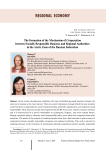
Статья научная
In the current development conditions, the issue of distributing social functions between the state and a business is the most relevant. There are several institutions through which the state transfers social functions to organizations: social entrepreneurship, nonprofit organizations, and corporate social responsibility. These processes are the most important for the RF Arctic zone, which is resource oriented, and it is characterized by a special vulnerability to technogenic, biogenic, and socio-cultural threats. Mining companies adopt a voluntary social responsibility policy more often than companies from other industries. The results of the analysis of conducted studies show that a little attention is paid to issues of cooperation between socially responsible companies and regional authorities. This work is devoted to studying processes of the formation of mechanisms defining cooperation between socially responsible companies and regional authorities of the RF Arctic zone. Primary and secondary sources of information served as the informational basis. To collect primary data, we used in-depth unstructured interviews. Secondary data sources were official data from government and companies’ websites, legal acts, and internal documentation of companies (annual reports, ordinances, regulations, policies, and reports on sustainable development). Content analysis of strategies, synthesis, and structural approach were used as methods of data interpretation. Access to company’s internal documentation and the lack of updates on government and companies’ official websites were restrictions of the research. Despite the existing bottlenecks in the research, the results are interesting for the further study of the mechanism of influence of business’ social responsibility on the territories’ socio-economic development and actualization of strategies for the Arctic regions’ development.
Бесплатно
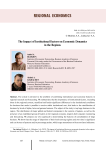
The impact of institutional factors on economic dynamics in the regions
Статья научная
The article is devoted to the problem of combining institutional and economic features in regional research and forecasting. We substantiate that the importance of institutional factors, including those in the regional context, manifests itself under significant differences in the institutional conditions for business that make it possible to receive stable institutional rent; this leads to the stratification of business by levels of alpha, beta and gamma business. The object of the study is top large business in the region. The distribution of major global and federal companies in the context of regions, as well as the presence of an established group of leaders in the regional economy, requires their separate monitoring and forecasting. We propose our own approach to determining the features of consolidation of large business. We show that the range of dispersion of their levels among regions and over time is significant and can be tens of percent and/or percentage points, which urges researchers to focus on these indicators. By comparing the features of consolidation of large business in the regions and using the constructed quantitative estimates, we substantiate the typology of methods (models) of economic growth in regions, depending on the presence or absence of major global, federal, and regional companies in them and their role in regional economy. Theoretical significance of this approach consists in combining the institutional analysis of the architecture of regional markets with the cost and physical aspects of the analysis; this will help improve the quality of diagnostics of regional and interregional problems and the validity of forecasts. Practical significance is determined by the possibilities of taking into account the architecture of regional markets in regional economic policy.
Бесплатно
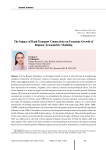
The impact of road transport connectivity on economic growth of regions: econometric modeling
Статья научная
For the Russian Federation, as the largest country in terms of area, the task of strengthening transport connectivity of territories: centers of economic growth, urban and rural areas, settlements within urban agglomerations, etc., is of exceptional importance. It is especially acute in the conditions of growing external sanctions pressure, which caused the need to multiply the strengthening of inter- and intra-regional ties of economic, migration, socio-cultural, scientific and technological nature. The aim of the research is to assess the impact of road transport connectivity on the economic growth of Russian regions. We used general scientific methods (analysis, synthesis, generalization) and methods of spatial econometrics to achieve it. In particular, we substantiated the existence of clustering of regions in the country space by level of per capita GRP and key indicators of motor transport connectivity based on the results of calculation of global and local Moran's spatial autocorrelation indices. As a result of the construction of multiple regression models with random effects with spatial lags (SAR, SEM, SDM, GSPRE models) and without them, the article shows that the greatest positive and statistically significant influence on the GRP of its subject is exerted by the factor concerning location of the region within the North of Russia, and on the GRP of other regions - by the density of highways. The scientific significance of the study consists in proving that the economic growth of each region of Russia in the period 2014-2022 was influenced by the level of intra-regional transport connectivity of both the subject itself and other regions. The results of our work contribute to the development of ideas about the impact of spatial factors on the economic growth of Russian regions and can be used by researchers in conducting research on similar topics, by public authorities in the development of strategic documents and specific projects for the development of territories
Бесплатно
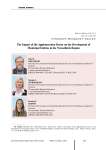
Статья научная
The paper considers municipal entities of the Novosibirsk Region in terms of the concentration of population and other resources in the metropolitan area. The aim of the research is to study the influence of population concentration in the Novosibirsk agglomeration on the development of the region's municipalities and the dynamics of the region's economy as a whole. The information base includes data from Rosstat and its Novosibirsk territorial division. The research period covers the time interval from 2005 to 2022. We propose an approach that allocates three territorial sectors of the economy, one of which is the Novosibirsk agglomeration, the other two include successfully developing and depressed municipalities, depending on the dynamics of their indicators. The resulting sectors are adjusted based on the location of municipal entities. Peripheral municipalities, being under the influence of the Novosibirsk agglomeration, are characterized by significant population migration, but economic indicators are growing faster in successfully developing municipalities compared to the Novosibirsk agglomeration. Using the Cobb - Douglas production functions constructed for three sectors we assess the impact of an increase or decrease in migration to the Novosibirsk agglomeration from other sectors. The results obtained make it possible to put forward some guidelines that will allow individual peripheral territories to develop successfully, primarily by creating favorable living conditions for the population. The study is part of a research project to assess the impact of the formation and development of agglomerations on the economy of the region as a whole. The results obtained can be used in regional strategic and program documents
Бесплатно
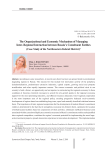
Статья научная
According to some researchers, in recent years there has been an upward trend in predominant stagnating regions in Russia. The reasons for this include low innovation activity of the periphery, deindustrialization, predominant extractive industries, capital exports, growing social and property stratification and other equally important reasons. The current economic and political crisis in our country is both a threat, an opportunity and an impetus to restructuring the regional economy. In these conditions it becomes extremely necessary to search for new growth points in the regional economy, support for the most promising industries, and efficient resource allocation. Inter-regional cooperation is the most important area of the regional policy, ensuring progressive balanced socio-economic development of regions based on establishing long-term, equal and mutually beneficial relations between them. The importance of inter-regional cooperation for the development of modern Russia's constituent entities is determined by the fact that it strengthens economic ties between them, optimizes the location of infrastructure facilities based on cooperation of their activities, eliminates inefficient financial costs associated with the creation of duplicate economic structures in Russia's constituent entities and unjustified inter-regional competition, combines the regions' economic potential for implementing the most large-scale investment projects, spreads innovative experience in innovation development...
Бесплатно
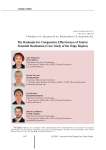
Статья научная
The article presents the analysis of long-term tourism development programs of the Volga Region. Great attention is given to the sector's financing measures set out in development programs. Domestic and foreign tourist potential assessment methods are analyzed. Tourist potential dynamics of the Volga Region is studied based on expert opinion. Using econometric approach the authors study the correlation between tourism investments and incomes of the Volga Region for the past six years - from 2009 to 2014. The analysis was carried out using statistics provided by the Russian Tourism Association and the Federal State Statistics Service of the Russian Federation by category of profitability from paid tourist services and from hospitality and catering services. The conducted analysis helped construct the figures showing the differentiation of the Volga regions by tourism investment efficiency and tourist potential realization. It is shown that tourist potential of the territories and its realization are highly differentiated...
Бесплатно
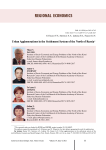
Urban agglomerations in the settlement system of the north of Russia
Статья научная
The article examines the evolution of the formation of cities and urban agglomerations in the North of Russia. The aim is to identify cities that meet the criteria of “northern urban agglomeration” from the large cities in the North of Russia. We propose criteria and indicators that make it possible to distinguish urban agglomerations in the urban space; it is noted that for northern urban agglomerations the evaluation criteria can be applied less strictly and indicators less important. We analyze the urban settlement of northern Russia, focusing on northern cities, their structure and the average density of settlements; we consider separately urban-type settlements that contribute to the population density of northern territories, increasing the density of settlements. The focus is on 18 cities with more than 100,000 inhabitants and four cities with a population of a hundred thousand in different years, the core cities have at least two satellite settlements, according to the criteria proposed, they correspond to the concept of an urban agglomeration core city. We consider and group the selected urban agglomerations according to the structure of satellite settlements and the population living in the zones located within 50, 100 and 150 km from the core. With the help of a review of domestic and foreign literature, we have revealed the essence and content of the category “agglomeration effect”. The article identifies three types of agglomeration effects: local objects sharing; cost reduction; and labor pooling. There are two types of effects: localization (clustering) and urbanization effects; the localization effect is the result of enterprises working together in a common area, the urbanization effect is the concentration of organizations in one area, regardless of whether there is thematic proximity between them. Along with the advantages, urban agglomerations cause environmental, economic, political and social problems and pose threats to the stability of small and medium-sized cities; increasing rural deprivation; which will cause further depopulation of large parts of the country, putting the security and integrity of the country at risk.
Бесплатно

“Smart” benchmarking as a basis for strategic planning in regional development
Статья научная
Addressing the problem of scientific substantiation of the region’s development priorities is an urgent issue for both regional researchers and territorial managers. At the same time, when determining the areas of development, the emphasis is often put on successful experience of the leading territories. This method of transplantation of best practices in order to improve the performance of the object under analysis is called benchmarking. In classical understanding, the key stages of regional benchmarking are: selection of the leading region for comparison, identifying the differences between the leading region and the region under analysis, analysis of key success factors of the leading region, and implementing successful experience in the economic practice of the research area. At the same time, the absence of preliminary analysis of reasons and prerequisites for achieving leadership by best regions, comparison of territories with objectively different characteristics of socio-economic development, leads to non-compliance with the most important principle of regional development planning - the principle of goal-setting...
Бесплатно

